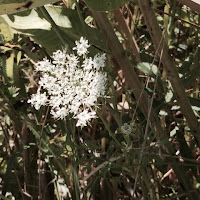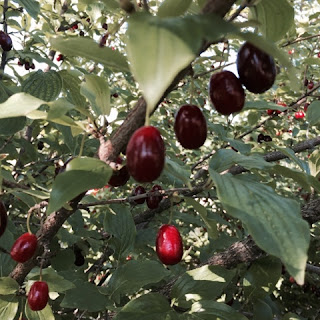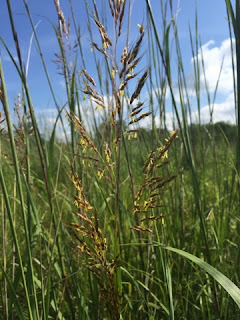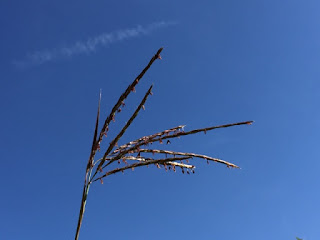I probably should just learn how to record and insert a sound clip... but instead I will try to describe the dog day sounds of the prairie. It's amazingly noisy out there. There are constant buzzings and and dronings, chirps and whirrs and chitters and trills. They come from every direction, and sound like they are both far away and incredible close. (Though I can NEVER find a cicada or a cricket when one seems to be singing right near me, it's crazy. The other day, I came across a co-worker who appeared to be staring into the branches of a tree. Knowing that someone staring at tree branches is most likely looking at something I will find interesting, I asked what he was looking at... the answer? Nothing -- he wanted to find the cicada that seemed so close but was completely elusive At any rate...) Some of the calls seem like a constant backdrop. Others crescendo and decrescendo. Still others pulse like waves. Mwow, mwow, mwow... There's my attempt at an onomatopoetic description. There's an incredible diversity of voices out there!
Of course, it's not really voices or singing (except for the few birds that do chime in). The insects that create our late summer prairie symphony -- cicadas, crickets, grasshoppers and katydids, at least -- are in the percussion section. Their sounds are created by stridulation, or rubbing body parts together. Many species have ridged or bumpy wings just for that purpose. The wing membranes also amplify the sounds, and they do a darn good job at it! Those are loud noises for little critters.
Enjoy the sounds of the season!
Monday, August 31, 2015
Web Sites
It was one of those beautiful, misty mornings when every spider web was covered in dew and illuminated by the faint morning light through the fog. On display were every size and shape of web... so spectacular. It is both awe-inspiring and a little bit scary to realize just how many spiders there must be out there, as almost every prairie plant, not to mention mailbox, fence, and power line, was adorned with a web.
Sunday, August 30, 2015
Weekend Update
 |
| Tall Coreopsis |
Also notable -- it's acorn-falling time. I've been noticing them on the ground for a while, but I figure it's not really truly acorn season until one falls through the air and hits me. That happened while I was running this weekend (a bur oak, too... those aren't small).
Friday, August 28, 2015
More Bugs, Baby!
 |
| Monarch Caterpillars -- one of several I saw! |
It occurs to me that most people don't define their days as "good bug days," or of they do, the mean a day in which they saw no bugs. But I define a good bug day as a day when the interesting arthropods keep happening. Of course, I don't take pictures of most of them. And in this case, I'm not even posting most of the good bug pictures I did take. I mean, how many do people really want to see? But I'll just say... it's a good bug time of year!
Thursday, August 27, 2015
Basswood, Linden, Honey-tree...
I guess it would be negligent not to explain the title. Growing up on the north shore, I called these trees linden trees, but apparently this is a fairly localized common name for what most people call the basswood. (My husband had no idea what I was talking about when I referenced a linden). And many people call them honey-trees, due to the sticky sap that drips from them... as anyone who has ever parked their car under one well understands. I guess we could clear up confusion and just say Tilia americana, but that's no fun...
Wednesday, August 26, 2015
It's Galling! and More
 |
| Hackberry "nipplegall" on the underside of a leaf. |
I know many people consider them ugly, especially given their prevalence on an infected tree... but I really like Hackberry Galls. This time of year, just before the adult insects emerge from the galls sometime in September, there are these tiny yellow insects inside. They're not really viable yet but they're big enough to walk around, and they're kind of cute. (Yes, I recognize that I've essentially killed the one pictured here to photograph it, but they seem like a pretty renewable resource, so to speak.)
These insects have a fascinating life cycle (similar to many gall-creating critters). When they come out in a month or so as adults, they will still be small, less than 1/4 inch long. They look like mini versions of their close relatives, cicadas and leaf hoppers. They will seek a relatively protected place to overwinter, such as inside cracks in bark, where they will hibernate. In the spring, they will awaken and lay their eggs on the underside of the new leaves of a hackberry tree. The baby bug causes the tree to start growing around it -- I believe because of an enzyme they secrete when they eat. The result is a gall, a growth made of plant material that houses the little insect. In this protected environment, the insects spend the summer sucking on sap until they are full grown and ready to come out and start this process over. The hackberry trees aren't harmed by the galls, other than in the aesthetic sense. (I don't think the trees actually care how they look).
 |
| I bit open the gall to study this fellow who was living inside! |
Sawtooth Sunflower
Sawtooth sunflowers are starting to bloom.. though they have a very long flowering range, quite a few are open. I don't think they've hit peak yet and I expect to see them at least until October. What sets these apart from other DYCs* is their odor. Since I was just a young nature nerd, I've been told by naturalists that they smell like chocolate. Now, there are a few possibilities here. Maybe I, or they, have bad senses of smell. Maybe they were just repeating what they'd been told, as I am admittedly doing here. Maybe these fine folks spent so much time being nature nerds that they didn't cook. I don't know. But I definitely don't smell chocolate. The plants do have a distinct odor, not quite sure how to describe it... (actually, that's the fourth and likely correct option -- we just don't have very good vocabularies of smell. If it's not "like something else" we can't capture it...) At any rate. Sawtooth sunflowers!
*that's, um... "darn yellow composites"
Tuesday, August 25, 2015
I Love to Learn Something New!
It's not often, to be honest, that I run across a flower that I just don't know. I mean, sometimes I have that "oh, I know that one but I can't remember the name," tip-of-the-tongue type of reaction, but I know that at some point I knew the name of that plant. It's familiar to me, even if it's identity eludes me. But today I came across the lovely little pinky-purple blooms pictured below and I had no idea what they were... a plant mystery! (Happy day!) A brief description: the photo may not communicate their diminutive size -- the plants are less than 2 feet tall, and the flowers themselves less than 1/2 inch. They were almost hidden among the other prairie plants, though they were living in a spot with shorter neighbors... also, notably, about 2 feet from the pond edge. The opposite leaves are slender and linear in shape. Flowers (or their white little buds) come off right from the leaf axils on very thin stalks. They are irregular in shape, with 5 spotted petals, very much like a foxglove, which makes sense because... my mystery plant is a Slender False Foxglove (Agalinis tenuifolia)! YEA! I learned something new!
Unseasonable
This time of year, it's pretty solidly late summer. The trees and the prairie are still predominantly green -- the late season yellow tinge colors the world... yes, some of the prairie plants are past peak or even done flowering, but still. It feels like summer.
Cottonwood trees seem to be providing the exception. Their leaves have already started to brown and fall. Walking past them, you sense two of the quintessential signs of autumn that even the least observant phenologists detect... the crunch of dead leaves underfoot, and the smell of them in the air. It's a little taste of what's to come!
Monday, August 24, 2015
Bad Guys
Usually I like to focus my observations and energy on natives... if I spent too much time paying attention to the invasives, I'd have a terribly negative attitude, as there are a lot of them. Still, sometimes its important to be aware of their phenophases...
Purple Loosestrife, ravager of wetlands, is in peak bloom now...
|
 |
| Sweet clover is blooming, slightly past peak. |
 |
| Queen Anne's Lace... many are blooming, many are already going to seed... |
 |
| Chickory -- probably peaked last week but there's still plenty. |
 |
| This photo is just to show the whitecaps on the lake -- it's another REALLY windy day! |
Sunday Sketches
I have decided I need to take the time to draw again. This weekend was nearly perfect for it, weather-wise (though the wind made my subjects prone to more movement than I prefer -- if I wanted moving subjects, I'd draw animals!
Sunday, August 23, 2015
Saturday, August 22, 2015
Friday, August 21, 2015
Wild Edibles
 Yesterday, I received a text message with a picture of these. I assumed the question would be "what are they" and I knew the answer to that right away... Cornelian Cherry Dogwood. They're not native, but are a lovely ornamental small tree, with very early yellow flowers and these bright red, olive-sized and -shaped fruits right now. I did NOT know the answer to the second question -- are they edible? Research ensued, and the answer turns out to be YES, they are... though they are a bit sour. Still, they (supposedly) make a lovely jam or preserve. As a canner with a sad inability to turn away from free local produce, I apparently have a new weekend project!
Yesterday, I received a text message with a picture of these. I assumed the question would be "what are they" and I knew the answer to that right away... Cornelian Cherry Dogwood. They're not native, but are a lovely ornamental small tree, with very early yellow flowers and these bright red, olive-sized and -shaped fruits right now. I did NOT know the answer to the second question -- are they edible? Research ensued, and the answer turns out to be YES, they are... though they are a bit sour. Still, they (supposedly) make a lovely jam or preserve. As a canner with a sad inability to turn away from free local produce, I apparently have a new weekend project!First of the Last
Thursday, August 20, 2015
Human Phenology
Today I wore my fleece. Over a sweatshirt. This is a first (in this nation) since May!
It's in the upper 50's, but it's very windy and cloudy and I'm wimpified -- it was in the 90's three days ago! So... August 20 is First Jacket Day, 2015!
Ugh... though school is in session, don't I technically have another month of summer?!?
It's in the upper 50's, but it's very windy and cloudy and I'm wimpified -- it was in the 90's three days ago! So... August 20 is First Jacket Day, 2015!
Ugh... though school is in session, don't I technically have another month of summer?!?
Wednesday, August 19, 2015
Buggin' Out
 |
| Clusters of milkweed bugs -- most young but of varying sizes, with a few adults scattered in -- clamber all over each other and the pods of the milkweed plants that host them. Very cool. |
 |
| Water lilies are in full bloom! |
Tuesday, August 18, 2015
Daily Discoveries
 |
| Rough blazing star is the last of the Liatris to bloom |
 |
| Red Osier Dogwood has very striking berries at this time of the year. |
 |
| This fellow's short adult life is over, but you can hear his cicada brethren singing, their droning song accompanying the late summer heat. |
 |
| Stiff goldenrod -- many people's choice for most desirable Solidago... |
Monday, August 17, 2015
School's Back -- Better Start Recording!
This is one of those phenological occurrences that get people more upset than excited. Pictured in the foreground is ragweed, and the yellowish tinge comes from pollen, and ragweed pollen causes lots of folks allergy issues. Pictured in the background is newly flowering goldenrod. Being a much more showy flower-er that happens to flower concurrently with ragweed, goldenrod often takes the heat for the sniffling and sneezing. Many people who think they are allergic to goldenrod are actually reacting to the ragweed.
On the other hand, the flowering and subsequent seeding of the prairie grasses is one of my favorite late summer happenings. The flowers are diminutive -- tiny little dangling jewels atop some of the prairie's tallest residents -- and so are often overlooked. But they are truly lovely... brightly colored and dancing in the breeze. I am always fascinated by the colors of the prairie grasses this time of year. Grass is green, you say? Not so if you look closely... There are many shades of yellow and purple, orange and red along with that green. (Everything but true blue -- which is funny because, you know, bluestem.)
On the other hand, the flowering and subsequent seeding of the prairie grasses is one of my favorite late summer happenings. The flowers are diminutive -- tiny little dangling jewels atop some of the prairie's tallest residents -- and so are often overlooked. But they are truly lovely... brightly colored and dancing in the breeze. I am always fascinated by the colors of the prairie grasses this time of year. Grass is green, you say? Not so if you look closely... There are many shades of yellow and purple, orange and red along with that green. (Everything but true blue -- which is funny because, you know, bluestem.)
 |
| Indian Grass flowers |
 |
| Big Bluestem flowers |
In insect news (no photos, sadly), monarchs abound both in their adult form and in their larval stages. We found a mid-sized caterpillar munching away yesterday!
And personally, I am LOVING the year of many dragonflies that we are having... Here's just one of many articles about the phenomena; any long time readers that have stuck with me through my breaks in coverage know I love odonata, and I certainly have been enjoying watching them this summer... and it's not just vast quantities, I feel like I've seen a lot of dragonfly biodiversity recently, too.
Labels:
butterflies,
dragonflies,
goldenrod,
grasses,
ragweed
Subscribe to:
Posts (Atom)

























